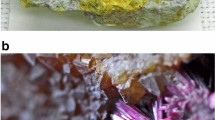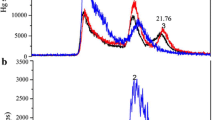Abstract
The metabolism of 74As-arsenate (As V, 0.4 mg As/kg body weight, IV) in marmoset monkeys (two males and two females) was studied. Unlike all other animal species studied so far, the marmoset was found to be unable to metabolize the arsenate to dimethylarsinic acid. Most of the absorbed arsenate was reduced to arsenite (As III) in vivo. Only 20% was excreted in the urine as unchanged As V. A further 20% of the dose was excreted as As III. The rest of the As III produced was bound to the tissues, giving a distribution picture very similar to that reported earlier for marmoset monkeys given arsenite. The tissues with longest retention of arsenic were the liver, upper gastrointestinal tract (oral cavity and esophagus), skin, kidneys and gall bladder. The pronounced accumulation in the liver resulted from specific binding of arsenic to the rough microsomal membranes, unique to this animal species.
Similar content being viewed by others
References
Anderson AC, Abdelghani AA (1980) Toxicity of selected arsenical compounds in short term bacterial bioassays. Bull Environ Contam Toxicol 24: 124–127
Bertolero F, Marafante E, Edel Rade J, Pietra R, Sabbioni E (1981) Biotransformation and intracellular binding of arsenic in tissues of rabbits after intraperitoneal administration of 74As labelled arsenite. Toxicology 20: 35–44
Buchet JP, Lauwerys R, Roels H (1981) Comparison of urinary excretion of arsenic metabolites after a single oral dose of sodium arsenite, monomethylarsonate, or dimethylarsinate in man. Int Arch Occup Environ Health 48: 71–79
Byron WR, Bierbower GW, Brouwer JB, Hansen WH (1967) Pathologic changes in rats and dogs from two-year feeding of sodium arsenite and sodium arsenate. Toxicol Appl Pharmacoll 10: 132–147
Charbonneau SM, Tam GKH, Bryce F, Zawidzka Z, Sandi E (1979) Metabolism of orally administered inorganic arsenic in the dog. Toxicol Lett 3: 107–113
Charbonneau SM, Hollins JG, Tam GKH, Bryce F, Ridgew JM, Willes RF (1980) Whole-body retention, excretion and metabolism of (74As) arsenic acid in the hamster. Toxicol Lett 5: 175–182
Crecelius EA (1977) Changes in the chemical speciation of arsenic following ingestion by man. Environ Health Perspect 19: 147–150
Dallner G (1979) Isolation of microsomal subfractions by use of density gradients. In: Fleischer S, Parcker L, (Eds) Methods in enzymology, Academic Press, New York, Vol LII, pp 71–84
Edwards T, Merilees HL, McBride BC (1975) Rapid, sensitive method for the separation and detection of arsenic compounds in biological systems. J Chromatogr 106: 210–212
Lanz H Jr, Wallace PC, Hamilton JG (1950) The metabolism of arsenic in laboratory animals using As74 as a tracer. Univ California Publ Pharmacol 2: 263–282
Lerman SA, Clarkson TW (1983) The metabolism of arsenite and arsenate by the rat. Fundam Appl Toxicol 3: 309–314
Lindgren A, Vahter M, Dencker L (1982) Autoradiographic studies on the distribution of arsenic in mice and hamsters administerd 74As-arsenite or -arsenate. Acta Pharmacol Toxicol 51: 253–265
Marafante E, Rade J, Sabbioni A, Bertolero F, Foa V (1981) Intracellular interaction and metabolic fate of arsenite in the rabbit. Clin Toxicol 18: 1335–1341
Marafante E, Bertolero F, Edel J, Pietra R, Sabbioni E (1982) Intracellular interaction and biotransformation of arsenite in rats and rabbits. Sci Total Environ 24: 27–39
Marafante E, Vahter M (1984) The effect of methyltransferase inhibition on the metabolism of 74As-arsenite in mice and rabbits. Chem Biol Interact 50: 49–57
Nordenson I, Sweins A, Beckman L (1981) Chromosome aberrations in cultured human lymphocytes exposed to trivalent and pentavalent arsenic. Scand J Work Environ Health 7: 277–281
Pomroy C, Charbonneau SM, McCullough RS, Tam GKH (1980) Human retention studies with 74As. Toxicol Appl Pharmacol 53: 550–556
Rowland IR, Davies MJ (1982) Reduction and methylation of sodium arsenate in the rat. J Appl Toxicol 2: 294–299
Sabbioni E, Marafante E, Bertolero F, Foa V (1979) Inorganic arsenic: metabolic patterns and identification of arsenic binding components in the rabbit. In: Proceedings, international conference, management and control of heavy metals in the environment, London, September, 1979. CEP Consultants Ltd., Edinburgh, pp 167–170
Sun TT, Shih C, Green H (1979) Keratin cyloskeletons in epithelial cells of internal organs. Proc Natl Acad Sci (USA) 76: 2813–2817
Tam GKH, Charbonneau SM, Bryce F, Lacroix G (1978) Separation of arsenic metabolites in dog plasma and urine following intravenous injection of 74As. Anal Biochem 86: 505–511
Tam GKH, Charbonneau SM, Bryce F, Pomroy C, Sandi E (1979) Metabolism of inorganic arsenic (74As) in humans following ozol ingestion. Toxicol Appl Pharmacol 50: 319–322
Vahter M (1981) Biotransformation of trivalent and pentavalent inorganic arsenic in mice and rats. Environ Res 25: 286–293
Vahter M, Envall J (1983) In vivo reduction of arsenate in mice and rabbits. Environ Res 32: 14–24
Vahter M, Marafante E (1983) Intracellular interaction and metabolic fate of arsenite and arsenate in mice and rabbits. Chem Biol Interact 47: 29–44
Vahter M, Norin H (1980) Metabolism of 74As-labeled trivalent and pentavalent inorganic arsenic in mice. Environ Res 21: 446–457
Vahter M, Marafante E, Lindgren A, Dencker L (1982) Tissue distribution and subcellular binding of arsenic in marmoset monkeys after injection of 74As-arsenite. Arch Toxicol 51: 65–77
Vahter M, Marafante E, Dencker L (1984) Tissue distribution and retention of 74As-dimethylarsinic acid in mice and rats. Arch Environ Contam Toxicol 13: 259–264
Wood JM, Cheh A, Dizikes LJ, Ridley WP, Rakow S, Lakowicz JR (1978) Mechanisms for the biomethylation of metals and metalloids. Fed Proc 37: 16–21
Author information
Authors and Affiliations
Additional information
At the time of this study, visiting researcher at the National Institute of Environmental Medicine and the Department of Environmental Hygiene, the Karolinska Institute, Stockholm, Sweden
Rights and permissions
About this article
Cite this article
Vahter, M., Marafante, E. Reduction and binding of arsenate in marmoset monkeys. Arch Toxicol 57, 119–124 (1985). https://doi.org/10.1007/BF00343121
Received:
Accepted:
Issue Date:
DOI: https://doi.org/10.1007/BF00343121




